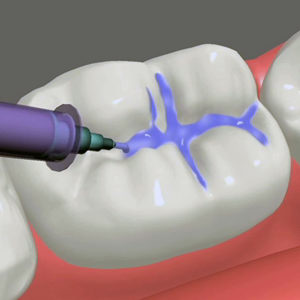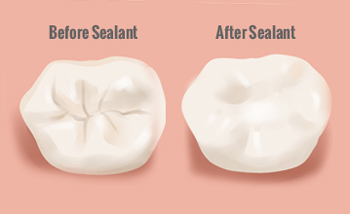What do you know about pit and fissure sealants?
They say a stitch in time saves nine.
That adage still holds true and never goes cold.

WHAT ARE PIT AND FISSURE SEALANTS?
Read Mrs Caroline’s story
Mrs Caroline was visiting the dentist at Schubbs Dental Clinics for the second time.
Three months before, she had picked up her close friend, Jumoke after a visit to the dentist. On the ride home, Jumoke who had been very pleased with the treatment she received at Schubbs Dental Clinics that day, had very excitedly spoken non-stop about her pleasant experience. Jumoke had also gone further to recommend that Mrs Caroline must visit the dentist.
Speaking of Jumoke’s experience, she had been visiting the dental clinic for about five years, along with her husband and their two children. In the past, they had received various dental treatments; from scaling and polishing to orthodontic therapy and now their teeth seemed to be in tip top condition. Despite having great teeth, they still visited the dental clinic regularly for dental check-ups and follow up appointments.
After listening to Jumoke that day, Mrs Caroline had agreed that she needed to see a dentist with her children especially since she was having a hard time getting her one year old son to brush his teeth, but she ignored her instincts as well as Jumoke’s advice.
It finally dawned on her, one Monday evening, when the unpleasant happened.
She was about to go to bed when her seven year old daughter came to her room in pain and pointing to a tooth. She checked her daughter’s teeth to find a hole, right on the chewing surface of one of her back teeth.
That night, it was hard getting her daughter to sleep, even after taking pain medications. Her heart broke as she watched her daughter in a lot of pain and she knew immediately, that they had to visit the dentist first thing the next morning even though she was scheduled for a business pitch presentation at work same morning.
At the dental visit, the dentist welcomed her and examined her daughter.
He identified three additional holes in her daughter’s teeth and explained that they would have to be filled. Thankfully, the decay in found in those teeth were not as bad as the one she noticed at home. After explaining the procedure to mother and daughter and answering all their questions, the dentist started a root canal treatment on the painful tooth and placed composite fillings on the other three. He gave Mrs Caroline a diet chart to monitor her daughter’s sugar intake before her second appointment.
On the second appointment, Mrs Caroline also, brought along her one year old son because she had come to realise that you are never too young to visit the dentist.
At her daughter’s last visit, the dentist had explained that the dental visits should have started even while she was pregnant for her children and that everyone required regular dental visits.
He explained further, that the decay in her daughter’s teeth could have been avoided if she had made regular visits and started from an early age.
On the second visit, the dentist explained the benefits of a reduced frequency of sugar intake and the importance of fissure sealants during child development.
Certainly, Mrs Caroline had learnt some important lessons.
MORE ON PIT AND FISSURE SEALANTS
The chewing surfaces on the back teeth have some natural hollows and grooves known as “pits and fissures”. These hollows or grooves are natural and are seen in everyone but they are deeper in some people that in others.
Those deep hollows and grooves make it easy for food particles and bacteria to pack on the surface of the teeth leading to tooth decay.
Tooth decay occurs when bacteria acts on the sugar in the food particles that stick to the teeth, the action of the bacteria, produces acids which break down the tooth.
Pit and fissure sealants are tooth-coloured dental materials placed in the deep hollows and grooves on the back teeth to prevent tooth decay. They act as barriers on the chewing surfaces of the teeth and prevent the packing of food debris and bacteria.
The procedure of sealant placement is safe, easy, painless and worth the effort.

WHAT TO EXPECT AT THE DENTAL CLINIC
Pit and fissure sealants can be placed for children, for adolescents and for adults.
Not everyone requires tooth sealing, sealants are only necessary if the grooves on the teeth are deep enough or if the teeth are at a high risk of decay.
The sealants are only placed on teeth that have fully come into the mouth.
In children, they are placed within 4 years after the first and second adult molar teeth fully come through. They can also be placed on baby teeth for a child who has had tooth decays and therefore, at high risk for more decays.
The dentist will introduce him/herself to you.
He/ she will take your history and examine you generally.
He /she will examine your oral hygiene and examine your teeth for anything abnormal or unhealthy.
He /she will examine your teeth for decay because the fissure sealants cannot be placed if the teeth already have holes.
The dentist will access your level of risk for tooth decay because sealants are necessary for teeth at high risk for tooth decay.
If you have not done a routine scaling and polishing procedure to clean your teeth, you may have to do so.
The dentist will clean the tooth to be sealed with a dry brush in a slow dental hand piece.
He/she will protect the tooth from moisture in the mouth with a dental rubber dam. If moisture or saliva gets in the way of the procedure, the sealant material may not bond properly to the tooth.
He/she will place a liquid or gel conditioner material called an “etchant” on the tooth which will be rinsed off and the tooth dried. The purpose of this step is to prepare the tooth so that the sealant will interlock and bind strongly with the tooth.
He/she will then place a little amount of the sealant in the hollows and grooves, ensuring that there are no voids or air bubbles on the teeth.
He/ she will then apply a special bright light to the tooth to harden the sealant material.
The dentist may also place the sealant on the inner and outer sides of the same tooth, and he or she will do this one side at a time.
At the end of the procedure, your dentist will check the teeth to ensure the sealants were properly placed.

POST-PROCEDURE CHECKLIST
- Inform your dentist of any complaints you may have
- Adhere to any post-procedure instructions you are given
- Book your next appointment before you leave the clinic
- Practice good oral hygiene
– Tooth sealing makes it easier to clean the teeth because the chewing surfaces of the back teeth are now smoother and the hard-to-reach grooves have been filled.
– Brush twice daily with a fluoridated toothpaste.
It is advised that children use age-appropriate toothpaste in pea sizes for children and smears for toddlers.
– Adults and children 8 years and older can use a medium-bristle toothbrushes. Soft bristle toothbrushes are appropriate for children younger than 8 years.
– Floss at least once a day. Flossing helps clean inbetween the teeth, those areas a toothbrush can’t get to. This is especially important for adult teeth which have tight spaces between them.
- See the dentist every six months even if you have no complaints or discomfort.
FAQ
The great news is that the answer is no.
As long as the sealants are present, the chewing surfaces of the back teeth are immune to decay.
The teeth will remain free of decay as long as the sealant is present.
Although sometimes the sealant is partially lost, there is still an increased resistance of the chewing surfaces of the tooth to decay because tags of the sealant material were locked into the tooth during placement of the sealants.
Pit and fissure sealants can last for many years but they will have to be checked from time to time in case they need to be repaired or replaced.
If your dentist is worried about the retention of the material, he may have to recheck in 6 months.
No.
Pit and fissure sealants are only placed on the back teeth. They can be placed on adult teeth that have just come through, adult teeth at risk of decay or baby teeth in a child with a history of tooth decay.
Pit and fissure sealants are not used for front teeth because the front teeth have no hollows or grooves on their chewing surfaces.
There are many great things about the procedure of sealant placement.
One of them is that it is painless.
The dentist does not cut or drill your teeth, there is usually no need for an injection and the teeth do not feel different after the procedure.
After the sealants are placed, they might wear off after a while.
This is nothing to be worried about as your dentist will check your teeth from time to time and replace them if need be.
You should brush your teeth appropriately without fear of losing the sealants.
There are different types of pit and fissure sealants made from resins, glass ionomer cements, composite and glass ionomer cement hybrids.
Some pit and fissure sealants release fluoride.
The fluoride helps to strengthen the sealed teeth and makes them more resistant to tooth decay.
All you need to do is book an appointment with one of our dentists at Schubbs Dental Clinics.
Your dentist will examine you and let you know if you need to get sealants placed.
If you do need to get sealants placed, he will explain the procedure to you and carry you along from start to finish.
The world is going through a difficult time in the wake of the COVID-19 pandemic, what better way to show how much you care for your loved one?
Show to your loved ones how much you care for them by being a part of their healthy-mouth journey ; encourage them to see a dentist, accompany them on their appointments, remind them to brush twice a day and support them all the way!
You are one step away from getting that dental care and attention you deserve and we are always ready to help you take care of your pearly whites.
Our doors and phone lines are open, Monday to Saturday.
Book an appointment with one of our dentists today!

